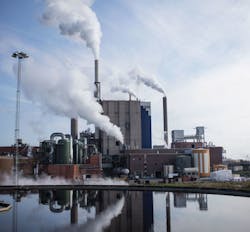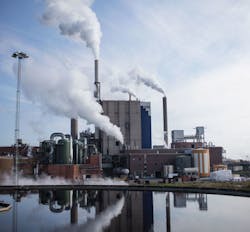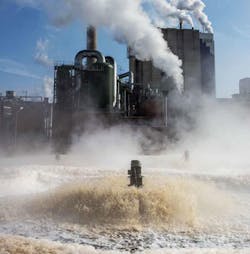By Jeff Gunderson
A research collective in Sweden examining waste streams from pulp and paper (P&P) mill processes has concluded that enormous potential exists for generating biogas. Scientists from Sweden's Linköping University, working with Scandinavian Biogas and consulting company Pöyry Sweden, and in collaboration with several P&P mills, studied 70 wastewater streams from 10 processes at seven mills and determined that as much as 100 million normal cubic meters1 of methane per year can be recovered, after processes have been fine-tuned.
Such an amount would represent an increase in biogas production of roughly 65 percent compared to Sweden's total production for 2012, according to Dr. Bosse Svensson, professor at Linköping University's Department of Environmental Change and one of the lead researchers.
The study, financed by Scandinavian Biogas, Linköping University, the Swedish Energy Agency, and various industrial partners, recently received further funding, enabling pilot trials to move from the university's labs to participating mills where tests will be scaled up.
Fredrik Nilsson, a senior consultant at Pöyry Sweden who is closely involved with the study, said the project originated after Pöyry, Scandinavian Biogas and Linköping University formed a partnership to investigate ways to reduce the large and problematic production of biosludge from Sweden's P&P mills. Nilsson, working with Svensson and Scandinavian Biogas director of research and development Jörgen Ejlertsson, began evaluating anaerobic digestion processes, which could produce biogas and conserve energy by decreasing the need for aerobic wastewater treatment.
"Once we started our research, we soon recognized the need to go more in depth in evaluating the different waste streams and experimenting with various treatment techniques depending on the specific production process at each mill," Nilsson said. "The cooperation gave us the opportunity to work close together with the mills to sample waste streams and collect production data."
The researchers determined that biogas potential was driven by many different factors -- such as the mills' pulping process, internal water circulation or the amount of supplied fresh water -- which influenced the type of chemicals released with effluents, in addition to total organic carbon and chemical oxygen demand (COD) concentrations.
"Biogas potential was also dependent on the bleaching strategies at the mills as well as the type of wood that is used as raw source material," Nilsson said.
The mills participating in the study included producers of kraft, thermo-mechanical, chemical thermo-mechanical, and neutral sulfite semi-chemical pulp. Both elementary and total chlorine-free bleaching processes were evaluated, and waste streams included material from wood rooms, cooking and oxygen delignification, bleaching (both acid and alkali effluents), drying, and paper/board machinery, as well as total effluents before and after sedimentation.
"We wanted to cover every kind of mill and every type of effluent in order to gain a complete understanding of the industry's true potential," said Ejlertsson. "And not only the potential but what treatment strategy represented the most effective utilization of each waste stream for producing the highest-yielding biogas volume allowable."
In conducting different evaluations of biosludge, fiber sludge and evaporation condensates, the researchers discovered that many existing treatment processes at P&P mills destroyed COD without the benefit of achieving energy conservation.
"Several waste streams produced through pulp and paper processes contain high COD concentrations, offering significant biogas recovery," Ejlertsson said. "In particular, our work showed strong potential in streams from bleaching plants, paper machines and wastewater from pre-sedimentation in mechanical pulp processes. Additionally, fiber sludge produced from pre-sedimentation in both kraft mills and sulphite mills offer an economical conversion of waste COD into methane."
Technologies
Two anaerobic-based technologies that proved effective in the laboratory for treating mill process waste streams are actively being scaled up for pilot testing at mill facilities.
One of the technologies -- upflow anaerobic sludge blanket treatment -- utilizes a granular sludge blanket that is suspended in a tank. Wastewater flowing up through the granular layer is processed by anaerobic microorganisms, trapping organic material while water is cleaned and methane is formed.
The second treatment technology -- completely stirred tank reactors with recirculation sludge -- works by first digesting and simultaneously stirring substrate in a closed chamber followed by centrifuging the substrate into digestion sludge and liquid. Succeeding this process, some of the sludge is returned to the reactor to increase the residence time for the microorganisms, thus achieving the best possible yield.
Trials will also be conducted to actively recirculate sludge from the mills' sedimentation pools to the reactors, which could increase the extraction of biogas and reduce costs associated with dewatering and pond aeration.
"Since the kraft mill produces very difficult COD, we found it advantageous to first use biological aerobic treatment at a very short sludge age, which renders the sludge more digestible," Ejlertsson said. "This represented a major achievement with our research -- as an alternative to composting, this sludge could instead be removed for biogas production."
By decreasing sludge age, the researchers found they could sustain a higher load on the aerobic treatment system, allowing them to utilize moving bed bioreactor technology.
"An MBBR system enables for an extremely short sludge age, which also more than triples the biomass production," Ejlertsson said. "Historically, biomass production has represented a problem for the pulp and paper industry, but that is also because biogas generation was not considered."
The research team believes that findings from the study could help P&P companies make better and more strategic future decisions. "This is especially true for companies that are expanding production and need to add additional treatment capacity," Svensson said. "As an alternative to traditional wastewater treatment, companies have an option that can save energy and generate revenues."
About the Author: Jeff Gunderson is a correspondent for Industrial WaterWorld. He is a professional writer with over 10 years of experience, specializing in areas connected to water, environment and building, including wastewater, stormwater, infrastructure, natural resources, and sustainable design. He holds a master's degree in environmental science and engineering from the Colorado School of Mines and a bachelor's degree in general science from the University of Oregon.
Notes:
1. One normal cubic meter (Nm3) of gas equals 1 cubic meter of gas at normal air pressure and 0°C. The energy content of 1 Nm3 of methane is also approximately equal to 1 L of gasoline, or 10 kWh.






